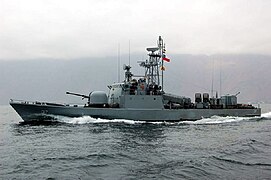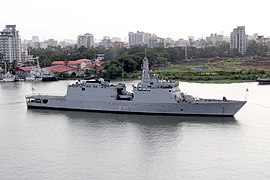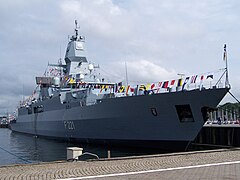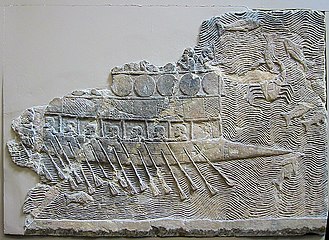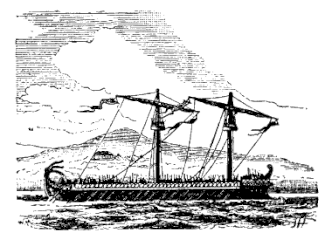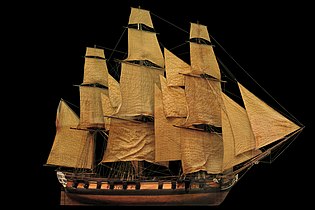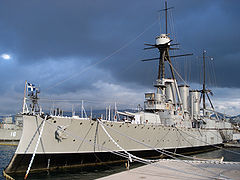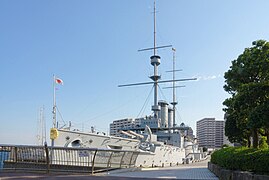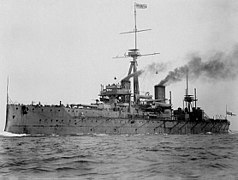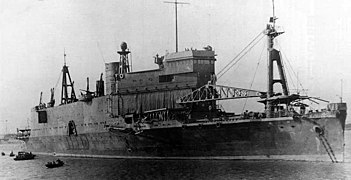Warship
This articleneeds additional citations forverification.(August 2016) |
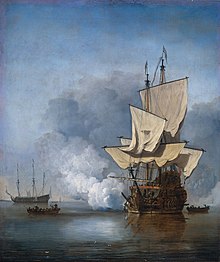
Awarshiporcombatant shipis ashipthat is used fornaval warfare.Usually they belong to thenavybranch of thearmed forcesof anation,[1]though they have also been operated by individuals,cooperativesandcorporations.As well as being armed, warships are designed to withstand damage and are typically faster and more maneuverable thanmerchant ships.Unlike a merchant ship, which carries cargo, a warship typically carries only weapons, ammunition and supplies for its crew.
In wartime, the distinction between warships and merchant ships is often blurred. Until the 17th century it was common for merchant ships to be pressed into naval service, and not unusual for more than half of afleetto be composed of merchant ships—there was not a large difference in construction, unlike the difference between a heavily armouredbattleshipand an ocean liner. Until the threat ofpiracysubsided in the 19th century, it was normal practice to arm largermerchant shipssuch asgalleons.Warships have also often been used astroop carriersor supply ships, such as by theFrench Navyin the 18th century or theImperial Japanese Navyduring the Second World War. In war since the early 20th century, merchant ships were often armed and used asauxiliary warships,such as theQ-shipsof theFirst World Warand thearmed merchant cruisersof theSecond World War.
Types and classes
[edit]The main types of warships today are, in order of decreasing size:aircraft carriers–amphibious assault ships–cruisers–destroyers–frigates–corvettes–fast attack boats.[2]A more extensive list follows:
- Amphibious warfare shipsare warships employed to land and support ground forces, such asmarines,on enemy territory during anamphibious assault.
- Amphibious assault shipis a type of amphibious warfare ship employed to land and support ground forces with ship-deployedhelicoptersandV/STOLaircraft on enemy territory by an amphibious assault.
- Amphibious transport dockis an amphibious warfare ship, that embarks, transports, and lands elements of a landing force for expeditionary warfare missions.
- Dock landing shipis an amphibious warfare ship with awell dockto transport and launchlanding craftandamphibious vehicles.
- Landing craftare small and medium seagoing watercraft, such asboatsandbarges,used to convey a landing force (infantry and vehicles) from the sea to the shore during an amphibious assault.
- Landing Craft Utilityis a type of landing craft used by amphibious forces to transport equipment and troops to the shore. They are capable of transporting tracked or wheeled vehicles and marines from amphibious assault ships tobeachheads.
- Landing Craft Mechanizedis a landing craft designed for carryingvehiclesduring amphibious assaults.
- Landing ship, tankis the naval designation for ships first developed duringWorld War IIto support amphibious operations by carryingtanks,armoured fighting vehicles,transport vehicles,cargo, and landingtroopsdirectly onto shore with nodocksorpiers.
- Landing Craft Supportwere two distinct classes of amphibious warfare vessels used by theUnited States Navyduring World War II to support landing crafts.
- Armed merchantmanis a type ofmerchant shipequipped withnaval guns,usually for defensive purposes, either by design or after the fact. In the days of sail,piracyandprivateers.
- Armed yachtswere modifiedyachtsthat were armed with weapons and were typically in the service of a navy.
- Balloon carrierwas a type of ship equipped with ahot-air balloontied to the ship with a rope orcable,which was used forobservation.This type of ship was later replaced by the seaplane carrier.
- Cottonclad warshipsweresteam-poweredwarships with bales ofcottonlining as armour used in theAmerican Civil War.The armaments consisted of aram,random numbers of differentcannonsandsharpshooters.
- Dispatch boatswere small boats, and sometimes large ships, tasked to carry military dispatches from ship to ship or from ship to shore or, in some cases from shore to shore. Dispatch boats were employed when other means of transmitting a message was not possible or safe or as quick.
- Aviso,a kind of dispatch boat
- Brig of Waris abrigarmed for use by anavy.
- Anti-submarine warfare carrieris a type of small aircraft carrier whose primary role is as the nucleus of ananti-submarine warfarehunter-killer group.
- Capital ship,the largest and most important ships in a nation's fleet. These were previously battleships, battlecruisers, and aircraft carriers, but the first two warship types are now no longer used.
- Aircraft carrier,a warship primarily armed withcarrier-based aircraft.
- Fleet carrieris an aircraft carrier designed to operate with the main fleet of a nation's navy.
- Light aircraft carrieris an aircraft carrier that is smaller than the standard carriers of a navy.
- Escort carrier,also called a "jeep carrier" or "baby flattop" is a slow type of aircraft carrier used during WWII.
- Battlecruiser,a ship with battleship-level armament and cruiser-level armour; typically faster than a battleship because the reduction in armour allowed mounting of more powerful propulsion machinery, or the use of a more slender hull shape with a lower drag coefficient.
- Battleship,a large, heavily armored warship equipped with many powerful guns. A term which generally post-dates sailing warships.
- Ironclad battleship,battleships built before thepre-dreadnoughtin the late 1850s to the early 1890s.
- Pre-dreadnought battleship,sea-going battleships built to a common design before the launch of dreadnoughts, between the mid-1880s to the early 1900s. Pre-dreadnoughts commonly featured a mixed main battery composed of several different caliber guns.
- Dreadnought,an early 20th-century battleship, which set the pattern for all subsequent battleship construction. Dreadnoughts differ from pre-dreadnoughts in that they feature an all-big-gun main battery. The advantage lies in that if all the big guns have the same characteristics, only one firing solution will be needed to aim them all.
- Fast battleshipswere battleships which emphasized speed without – in concept – undue compromise of either armor or armament
- Aircraft carrier,a warship primarily armed withcarrier-based aircraft.
- Bomb vesselswere wooden sailing ships which carriedmortarsinstead ofcannons.
- Coastal defence ship,a type of cruiser-sized warship built for the purpose of coastal defense.
- Commerce raider,any armed vessel—privately or government-owned—sanctioned to raid a nation's merchant fleet.
- Merchant raidersare disguised commerce raiders.
- Corvetteswere small ships during the age of sail. The concept was revived again in WWII as a merchant convoy escort and anti-submarine ship. They were only used by the Royal Navy and theRoyal Canadian Navy.Today they are used foranti-submarine warfareand patrolling.[3]
- Cruiser,a fast, independent warship. Traditionally, cruisers were the smallest warships capable of independent action. Along with battleships and battlecruisers, they have largely vanished from modern navies.
- Armored cruiserwas a type of warship of the late 19th and early 20th centuries. It was designed like other types of cruisers to operate as a long-range, independent warship, capable of defeating any ship apart from a battleship and fast enough to outrun any battleship it encountered
- Scout cruiserwas a type of warship of the early 20th century, which were smaller, faster, more lightly armed and armoured than protected cruisers or light cruisers, but larger than contemporary destroyers. They were used forscouting.
- Protected cruiseris a type of naval cruiser of the late-19th century, gained their description because an armored deck offered protection for vital machine-spaces from fragments caused by shells exploding above them.
- Torpedo cruiseris a type of cruiser that is armed primarily withtorpedoes.
- Unprotected cruiserwas a type of naval cruiser in use during the early 1870sVictorianorpre-dreadnought era.
- Heavy cruiserwas a type of cruiser, a naval warship designed for long range and high speed, armed generally with naval guns of roughly 203 mm (8 in) caliber; its parameters were dictated by theWashington Naval Treatyof 1922 and theLondon Naval Treatyof 1930.
- Light cruiseris a type of small or medium-sized warship. The term is a shortening of the phrase "lightarmored cruiser",describing a small ship that carried armor in the same way as an armored cruiser: a protective belt and deck.
- Large cruiseris the class of thebattlecruiser-sizedAlaska-class cruisersof theUnited States NavyduringWorld War II.
- Guided missile cruisersare cruisers armedanti-ship missiles.
- Aircraft cruiser(also known as aviation cruiser or cruiser-carrier) is a type of warship that combines the features of the aircraft carrier and a surface warship, such as a cruiser or battleship.
- Destroyer,a fast and highly maneuverable warship, traditionally incapable of independent action. Originally developed to counter the threat oftorpedo boats,they are now the largest independent warship generally seen on the ocean.
- Guided missile destroyerare destroyers armed withanti-ship missiles.
- Destroyer escortwas theUnited States Navymid-20th-century classification for a 20-knot (37 km/h; 23 mph), warship designed with the endurance necessary to escort mid-ocean convoys of merchant marine ships similar to frigates.
- East Asianwarships
- Geobukseon(literally Turtle ship) were wooden sail and oar propelledKoreanwarships armed with cannons.
- Panokseon(literally board roofed ship) were a type ofKoreanwooden warships propelled by both sailing and rowing armed with cannons andHwachamultiple rocket launchers.
- Atakebunewere wooden oar propelled16th Century Japanesewarships armed with few cannons, arquebusiers, and archers. They were mostly bulky floating fortifications.
- Mengchong(literally Covered Assaulter) was a type of leather-covered assault warship used in the 2nd and 3rd centuries CE in China.
- Louchuan(literally Tower Ship) was a type of warship used as a floating fortress in Ancient China. The Louchuan was meant to board troops onto enemy ships. Although they were also armed withtrebuchetsfor ranged combat.
- Wugongchuan(literally Centipede Ship) was a Chinese oared vessel of the 16th century inspired by the Portuguese galley.
- Fast attack craftsare a small, fast, agile, offensive, often affordable type of warships armed withanti-ship missiles,guns ortorpedoes.
- Fire ship,a vessel of any sort set on fire and sent into an anchorage or fleet with the intention of causing destruction and chaos. Exploding fire ships are calledhellburners.
- Frigate,originally a medium-sized sailing ship. Although they date back to the 17th century, frigates in modern navies are typically used to protect merchant ships and other warships.
- Armoured frigateare frigates with armour which was added to ships based on existing frigate and ship of the line designs. The additional weight of the armour on these first ironclad warships meant that they could have only one gun deck, and they were technically frigates, even though they were more powerful than existing ships-of-the-line and occupied the same strategic role.
- Guided missile frigatesare frigates armed withanti-ship missiles.
- Galleass,a sailing and rowing warship, equally well suited to sailing and rowing.
- Galleon,a 16th-century armed cargo carriers.
- Hellenistic galleys,warships propelled by oars with a sail for use in favorable winds used in theMediterranean Sea.
- Bireme,an ancient vessel, propelled by two banks of oars.
- Trireme,an ancient warship propelled by three banks of oars.
- Quadrireme,an ancient warship invented inCarthagewith two levels of oarsmen, and was therefore lower than the quinquereme.
- Quinquereme,an ancient warship propelled by three banks of oars. On the upper row, two rowers hold one oar; on the middle row, two rowers; and on the lower row, one man to an oar.
- Hexareme,an ancient warship invented inSyracuse.The exact arrangement of the hexareme's oars is unclear. If it evolved naturally from the earlier designs, it would be a trireme with two rowers per oar.
- Septireme,an ancient warship invented by theMacedonia,the septireme was derived by adding a standing rower to the lower level of the hexareme.
- Octeres,very little is known about the octeres, at least two of their type were in the fleet ofPhilip V of Macedonat theBattle of Chios.
- Enneres,a type of warship whose oaring system may have been a modification of the quadrireme, with two teams of five and four oarsmen.
- Deceres,a type of warship which is present alongside "nines" in the fleet ofAntigonus I Monophthalmusin 315 BC. It is most likely that the "ten" was derived from adding another oarsman to the "nine".
- Tessarakonteres,a very largecatamarangalley reportedly built byPtolemy IV PhilopatorofEgypt.It had sevennaval rams,with one primary, and the deck would have provided a stable platform forcatapultsthat were often mounted on supergalleys. However, the "forty" was likely just a showpiece; Plutarch describes the ship as for exhibition only.
- Lembos,light warships most commonly associated with the vessels used by theIllyrian tribes,chiefly for piracy, in the area ofDalmatia.Was soon adopted byMacedonia,Seleucid Empire,Roman RepublicandSparta.
- Hemiolia,light and fast warship that appeared in the early 4th century BC. It was particularly favoured by pirates in the eastern Mediterranean, but also used by Alexander the Great as far as the riversIndusandJhelum,and by the Romans as a troop transport. According to one view, it was manned by half the number of oarsmen to make room for the soldiers. According to another, there were one and a half files of oarsmen on each side, with the additional half file placed amidships, where the hull was wide enough to accommodate them.
- Trihemiolia,this type was classed with the trireme, and had two and a half files of oarsmen on each side. Judging from theLindosrelief and the famousNike of Samothrace,both of which are thought to representtrihemioliai,the two upper files would have been accommodated in an oarbox, with the half-file located beneath them in the classicthalamitaiposition of the trireme.
- Liburna,a type of small galley used for raiding and patrols. It was originally used by theLiburnians,a pirate tribe fromDalmatia,and later used by theRoman Navy.It had one bench with 25 oars on each side, while in the lateRoman Republic,it was equipped with two banks of oars (a bireme), remaining faster, lighter, and more agile than triremes.
- Gunboatsare naval watercraft designed for the express purpose of carrying one or more guns tobombard coastal targets.
- River gunboatis a type of gunboat for riverine use.
- Flat-iron gunboatswere a number of classes of coastal gunboats generally characterized by small size, low freeboard, the absence of masts, and the mounting of a single non-traversing large gun, aimed by pointing the vessel.
- Torpedo gunboatwere a form of gunboat armed withtorpedoesand designed for hunting and destroying smaller torpedo boats.
- Motor gunboatis a type of a fast gunboat armed withmachine-gunsandautocannons.
- Grabwas a type of ship common on theMalabar Coastin the 18th and 19th centuries. The ghurāb was originally a galley, but the type evolved into sailing ships armed withcannons.
- Gallivatwere small, armed type of boats, with sails and oars, armed withswivel gunsand used on theMalabar Coastin the 18th and 19th centuries.
- Helicopter carrier,an aircraft carrier especially suited to carryhelicoptersandV/STOLaircraft.
- Ironclad,a wooden warship with external iron plating.
- Casemate ironcladwere a type of ironclad gunboats used in theAmerican Civil War.
- Central battery shipin European continental navies, was a development of the (high-freeboard) broadside ironclad of the 1870s
- Turret shipwas a 19th-century type of warship, the earliest to have their guns mounted in a revolvinggun turret,instead of abroadsidearrangement.
- Floating batteryis a kind of armed watercraft, often improvised or experimental, which carries heavy armament but has few other qualities as a warship.
- Littoral Combat Shipis aUnited States Navyclassification of warships with the size and role of corvettes.
- Longship,aVikingraiding ship.
- Maritime Southeast Asianwarships:
- Man-of-war,a British Navy expression for a sailing warship.
- Minesweeperare small warships designed to remove or detonatenaval mines.
- Minehunterare naval vessels that seek, detect, and destroys individual naval mines.
- Mine countermeasures vesselsare atype of naval ships designed for the location of and destruction of naval mines which combines the role of a minesweeper and minehunter in one hull.
- Minelayerare naval vessels that plantnaval minesoffshore.
- Missile boatsare small, fast warship armed withanti-ship missiles.
- Monitor,a type of small, heavily gunned warships with shallow draft designed forshore bombardment.
- River monitor,a type ofmonitorsused in rivers.
- Breastwork monitorwas a modification of the monitor bySir Edward Reedof theRoyal Navy.
- Naval trawlersare vessels built along the lines offishing trawlersbut fitted out for naval purposes
- Naval driftersare boats built along the lines of a commercialfishing drifterbut fitted out for naval purposes.
- Patrol vesselsare relatively small naval vessels generally designed for coastal defence, border protection, immigration law-enforcement, search and rescue duties.
- Penjajapwere galley-like warships used by severalAustronesianethnic groups inMaritime Southeast Asiaarmed withLantakaswivel guns.
- Q-ship,also known as Q-boats, decoy vessels, special service ships, or mystery ships, were heavily armed merchant ships with concealed weaponry, designed to lure submarines into making surface attacks. This gave Q-ships the chance to open fire and sink them.
- Seaplane tenderswere a type of ship used to carryseaplanesinto the open sea. They are considered by some as the predecessor of the aircraft carrier.
- Submarine chaseris a small warship used inanti-submarine warfare.
- Ship of the line,a sailing warship capable of standing in theline of battle.A direct predecessor to the later battleship.
- Sloop-of-warwas a sailing vessel category later revived in WWII as a convoy escort ship.
- Screw sloopwas apropeller-driven sloop-of-wars used during the mid-19th Century.
- Submarine,are ships capable of staying submerged for days. Modern submarines can stay underwater for months, with food supplies as the only limiting factor.
- Cruiser submarinewere a type of a very large submarine designed to remain at sea for extended periods in areas distant from base facilities.
- Coastal submarineor littoral submarine is a small, maneuverable type of submarine with shallow draft well suited to navigation of coastal channels and harbors.
- Fleet submarineis a type of submarine with the speed, range, and endurance to operate as part of a navy's battlefleet.
- Midget submarineis any submarine under 150 tons, typically operated by a crew of one or two but sometimes up to six or nine
- Submarine aircraft carrieris a submarine equipped with aircraft for observation or attack missions. These submarines saw their most extensive use during World War II, although their operational significance remained small
- Attack Submarineis a submarine with the purpose of attacking other submarines.
- Ballistic Missile Submarineis a submarine capable of deployingsubmarine-launched ballistic missiles(SLBMs) withnuclear warheads.
- Cruise missile submarineare submarines equipped withcruise missiles
- Torpedo boat,are small, fast surface vessels designed for launchingtorpedoes.
- Torpedo ramis a type of torpedo boat combining aramwithtorpedotubes.
- Motor torpedo boatis a type of fast torpedo boat, especially of the mid 20th century.
- War canoewas a kind of watercraft of thecanoetype designed and outfitted for warfare usingbow,spearandshieldwieldingwarriors.During the gunpowder era a single brass or ironcannonwas mounted on theboworsternalong withmusketeers.These warships were used by manytribesandculturesall around the globe.
-
A fast attack craft of theChilean Navy
-
AnOsaI classmissile boat in 1983.
-
INSSunayna,an IndianOffshore Patrol Vessel
-
Magdeburg,a GermanBraunschweig-class corvette(2008)
-
A GermanSachsen-class frigate(2006)
-
British destroyerHMSDaringvisiting Gibraltar in 2016
-
American cruiserUSSPort Royalin September 2003
-
Russian battlecruiserKirov,1983
History and evolution of warships
[edit]First warships
[edit]The first evidence of ships being used for warfare comes fromAncient Egypt,specifically the northernNile Rivermost likely to defend againstMediterraneanpeoples. Thegalleywarship most likely originated inCretean idea which was soon copied and popularized by thePhoenicians.In the time ofMesopotamia,Ancient Persia,Phoenicia,Ancient Greeceand theAncient Rome,warships were alwaysgalleys(such asbiremes,triremesandquinqueremes): long, narrow vessels powered by banks ofoarsmenand designed to ram and sink enemy vessels, or to engage thembow-first and follow up with boarding parties. The development ofcatapultsin the 4th century BC and the subsequent refinement of this technology enabled the first fleets ofsiege engine- equipped warships by theHellenistic age.Duringlate antiquity,rammingfell out of use and thegalley tacticsagainst other ships used during theMiddle Agesuntil the late 16th century focused on boarding.
The Age of Sail
[edit]Naval artillerywas redeveloped in the 14th century, butcannondid not become common at sea until the guns were capable of being reloaded quickly enough to be reused in the same battle. The size of a ship required to carry a large number of cannons made oar-based propulsion impossible, and warships came to rely primarily on sails. The sailingman-of-waremerged during the 16th century.
By the middle of the 17th century, warships were carrying increasing numbers of cannons on theirbroadsidesandtacticsevolved to bring each ship's firepower to bear in aline of battle.The man-of-war now evolved into theship of the line.In the 18th century, thefrigateandsloop-of-war– too small to stand in the line of battle – evolved to escortconvoytrade, scout for enemy ships andblockadeenemy coasts.[4]
-
Diagrams of first and third rate warships, England, 1728
-
American sailingfrigateUSSConstitution
-
Americansloop-of-warUSSConstellationin 2012
-
Starboard side of the Britishship of the lineHMSVictory
Steel, steam and shellfire
[edit]During the 19th century a revolution took place in the means ofmarine propulsion,naval armamentandconstruction of warships.Marine steam engineswere introduced, at first as an auxiliary force, in the second quarter of the 19th century. TheCrimean Wargave a great stimulus to the development of guns. The introduction of explosiveshellssoon led to the introduction ofiron,and latersteel,naval armourfor the sides and decks of larger warships. The firstironcladwarships, the FrenchGloireand BritishWarrior,made wooden vessels obsolete. Metal soon entirely replaced wood as the main material for warship construction.
From the 1850s, the sailing ships of the line were replaced by steam-poweredbattleships,while the sailingfrigateswere replaced by steam-poweredcruisers. The armament of warships also changed with the invention of the rotatingbarbettesandturrets,which allowed the guns to be aimed independently of the direction of the ship and allowed a smaller number of larger guns to be carried.
The final innovation during the 19th century was the development of thetorpedoand development of thetorpedo boat.Small, fast torpedo boats seemed to offer an alternative to building expensive fleets of battleships.
-
Frenchship-of-the-lineNapoléon,the first steam powered battleship.
-
Casemate ironcladUSSCairoon a contemporary photograph.
-
HMSDevastationwas the first sea-going ironclad to not use sails and completely rely on its steam engines.
Pre-dreadnought era
[edit]Pre-dreadnought battleshipswere sea-going battleships built between the mid- to late- 1880s and 1905, before the launch of HMS Dreadnought in 1906. The pre-dreadnought ships replaced the ironclad battleships of the 1870s and 1880s. Built from steel, protected by case-hardened steel armour, and powered by coal-fired triple-expansion steam engines, pre-dreadnought battleships carried a main battery of very heavy guns in fully-enclosed rotating turrets supported by one or more secondary batteries of lighter weapons. The role ofcorvettes,sloopsandfrigateswere taken by new types of ships likedestroyers,protected cruisersandarmoured cruisers.
Since 1906
[edit]The dreadnought era
[edit]Another revolution in capital warship design began shortly after the start of the 20th century, when Britain launched theRoyal Navy's all-big-gunbattleshipDreadnoughtin 1906. Powered bysteam turbines,it was bigger, faster and more heavily gunned thanany existing battleships,which it immediately rendered obsolete. It was rapidly followed by similar ships in other countries. The Royal Navy also developed the firstbattlecruisers.Mounting the same heavy guns as thedreadnoughtson an even largerhull,battlecruisers sacrificed armour protection for speed. Battlecruisers were faster and more powerful than all existing cruisers, but much more vulnerable to shellfire than contemporary battleships. Thetorpedo-boat destroyerwas developed at the same time as the dreadnoughts. Bigger, faster and more heavily gunned than thetorpedo boat,the destroyer evolved to protect thecapital shipsfrom the menace of the torpedo boat.
At this time, Britain also introduced the use offuel oilto power steam warships, instead of coal. Oil produced twice as much power per unit weight as coal, and was much easier to handle.[5][6]Tests were conducted by the Royal Navy in 1904 involving the torpedo-boat destroyerSpiteful,the first warship powered solely by fuel oil.[7][8]These proved its superiority, and all warships procured for the Royal Navy from 1912 were designed to burn fuel oil.[9][10]
-
The all-big-gun steam-turbine-drivendreadnought battleshipHMSDreadnought
-
HMSInvincible,the firstbattlecruiser
Obsolescence of battleships
[edit]During the lead-up to theSecond World War,Germanyand the United Kingdom once again emerged as the two dominantAtlanticsea powers. The German navy, under theTreaty of Versailles,was limited to only a few minor surface ships. But the clever use of deceptive terminology, such asPanzerschiffedeceived the British andFrenchcommands. They were surprised when ships such asAdmiral Graf Spee,Scharnhorst,andGneisenauraidedAlliedsupply lines. The greatest threat however, was the introduction of theKriegsmarine's largest vessels,BismarckandTirpitz.Bismarckwas heavily damaged and sunk/scuttled after a series of sea battles in the north Atlantic in 1941, whileTirpitzwas destroyed by theRoyal Air Forcein 1944. The BritishRoyal Navygained dominance of the European theatre by 1943.

The Second World War brought massive changes in the design and role of several types of warships. For the first time, theaircraft carrierbecame the clear choice to serve as the main capital ship within a naval task force. World War II was the only war in history in which battles occurred between groups of carriers. World War II saw the first use ofradarin combat. It brought the first naval battle in which the ships of both sides never engaged in direct combat, instead sending aircraft to make the attacks, as in theBattle of the Coral Sea.
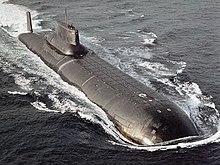
Cold War-era
[edit]Modern warships are generally divided into seven main categories, which are:aircraft carriers,cruisers,[a]destroyers,frigates,corvettes,submarines,andamphibious warfare ships.Battleships comprise an eighth category, but are not in current service with any navy in the world. Only the deactivated AmericanIowa-class battleshipsstill exist as potential combatants, and battleships in general are unlikely to re-emerge as a ship class without redefinition. Thedestroyeris generally regarded as the dominant surface-combat vessel of most modern blue-water navies. However, the once distinct roles and appearances ofcruisers,destroyers,frigates,andcorvetteshave blurred. Most vessels have come to be armed with a mix of anti-surface, anti-submarine and anti-aircraft weapons. Class designations no longer reliably indicate a displacement hierarchy, and the size of all vessel types has grown beyond the definitions used earlier in the 20th century. Another key difference between older and modern vessels is that all modern warships are "soft", without the thick armor and bulging anti-torpedo protection of World War II and older designs.
Mostnaviesalso include many types of support andauxiliary vessels,such asminesweepers,patrol boatsandoffshore patrol vessels.
By 1982 theUnited Nations Convention on the Law of the Sea(UNCLOS) treaty negotiations had produced a legal definition of what was then generally accepted as a late-twentieth century warship. The UNCLOS definition was: "A warship means a ship belonging to the armed forces of a State bearing the external marks distinguishing such ships of its nationality, under the command of an officer duly commissioned by the government of the State and whose name appears in the appropriate service list or its equivalent, and manned by a crew which is under regular armed forces discipline."[1]
Development of the submarine
[edit]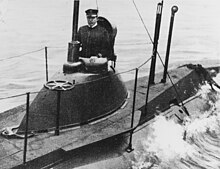
The first practical submarines were developed in the late 19th century, but it was only after the development of thetorpedothat submarines became truly dangerous (and hence useful). By the end of theFirst World Warsubmarines had proved their potential. During theSecond World WarNazi Germany's fleet ofU-boats(submarines) almost starved Britain into submission and inflictedhuge losseson US coastal shipping. The success of submarines led to the development of newanti-submarineconvoyescorts during the First and Second World Wars, such as thedestroyer escort.Confusingly, many of these new types adopted the names of the smaller warships from theage of sail,such ascorvette,sloopandfrigate.
Development of the aircraft carrier
[edit]Aseaplane tenderis a ship that supports the operation ofseaplanes.Some of these vessels, known as seaplane carriers, could not only carry seaplanes but also provided all the facilities needed for their operation; these ships are regarded by some as the first aircraft carriers and appeared just before theFirst World War.
A major shift in naval warfare occurred with the introduction of theaircraft carrier.First atTarantoand then atPearl Harbor,the aircraft carrier demonstrated its ability to strike decisively at enemy ships out of sight and range of surface vessels. By the end of the Second World War, the carrier had become the dominant warship.
-
Foudre,the firstseaplane carriercirca 1914.
-
HMSInvincible(1991), alight aircraft carrier
-
USSEnterprise(1961) and escorts
Development of the amphibious assault ship
[edit]Shinshū Maruwas a ship of theImperial Japanese Armyduring World War II. She was the world's first purpose-builtlanding craft carriership, and a pioneer of modern-dayamphibious assault ships.During some of her operations, she was known to have used at least four cover names, R1, GL, MT, and Ryujo Maru.[citation needed]
An amphibious warfare ship is an amphibious vehicle warship employed to land and support ground forces, such asmarines,on enemy territory during an amphibious assault. Specialized shipping can be divided into two types, most crudely described as ships and craft. In general, the ships carry the troops from the port of embarkation to the drop point for the assault and the craft carry the troops from the ship to the shore. Amphibious assaults taking place over short distances can also involve the shore-to-shore technique, where landing craft go directly from the port of embarkation to the assault point. Amphibious assault ships have a well deck with landing craft which can carrytanksand otherarmoured fighting vehiclesand also have a deck like ahelicopter carrierfor helicopters andV/STOLaircraft.
-
Japaneseamphibious assault shipShinshū Maru
-
USSIwo JimaatNew Orleans,2005
-
Stern view ofŌsumi-class tank landing ship
See also
[edit]Notes
[edit]- ^TheKirov-classbattlecruiseris a guided missile cruiser that straddles the line between a heavy cruiser and a battlecruiser. They are often called battlecruiser by Western defense commentators.[11]
References
[edit]Footnotes
[edit]- ^ab"United Nations Convention on the Law of the Sea. Part II, Subsection C".United Nations.Retrieved28 June2015.
- ^Brook, Henry (2012).Warships.Usborne. pp. 4 to 7.ISBN9781474915854.
- ^"Corvette | Fast, Maneuverable & Deadly".Britannica.
- ^Winfield, Rif; Roberts, Stephen S. (2017-10-30).French Warships in the Age of Sail 1626–1786.Pen & Sword Books Limited.ISBN9781473893535.
- ^Bacon 1901,p. 246.
- ^Dahl 2001,p. 51.
- ^Anon. 1904b,p. 27.
- ^Lyon 2005,p. 80.
- ^Lyon 2005,p. 97.
- ^Siegel 2002,p. 181.
- ^Armi da guerra,De Agostini, Novara, 1985.
Bibliography
[edit]- Anon. (1904b),"The British Admiralty...",Scientific American,91(2),ISSN0036-8733
- Bacon, R.H.S.(1901),"Some notes on naval strategy",in Leyland, J. (ed.),The Naval Annual 1901,pp. 233–52,OCLC496786828
- Dahl, E.J. (2001),"Naval innovation: From coal to oil"(PDF),Joint Force Quarterly(Winter 2000–01): 50–6,archived(PDF)from the original on 22 October 2016,retrieved28 November2016
- Lyon, D. (2005) [1996],The First Destroyers,Mercury,ISBN1-84560-010-X
- Siegel, J. (2002),Endgame: Britain, Russia, and the Final Struggle for Central Asia,I.B. Tauris,ISBN1-85043-371-2

